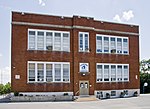Charles Downs II House
Berkeley County, West Virginia Registered Historic Place stubsFederal architecture in West VirginiaHouses completed in 1835Houses in Berkeley County, West VirginiaHouses on the National Register of Historic Places in West Virginia ... and 1 more
National Register of Historic Places in Berkeley County, West Virginia

Charles Downs II House is a historic home located near Marlowe, Berkeley County, West Virginia. It was built in 1835 and is a two-story, L-shaped, brick dwelling measuring 53 feet wide and 50 feet deep. It is five bays wide and three bays deep. Also on the property are a cement block garage and wood-frame shed dating to the 1920s.It was listed on the National Register of Historic Places in 1991.
Excerpt from the Wikipedia article Charles Downs II House (License: CC BY-SA 3.0, Authors, Images).Charles Downs II House
Bowie Drive,
Geographical coordinates (GPS) Address Nearby Places Show on map
Geographical coordinates (GPS)
| Latitude | Longitude |
|---|---|
| N 39.571944444444 ° | E -77.893333333333 ° |
Address
Bowie Drive
Bowie Drive
25419
West Virginia, United States
Open on Google Maps







